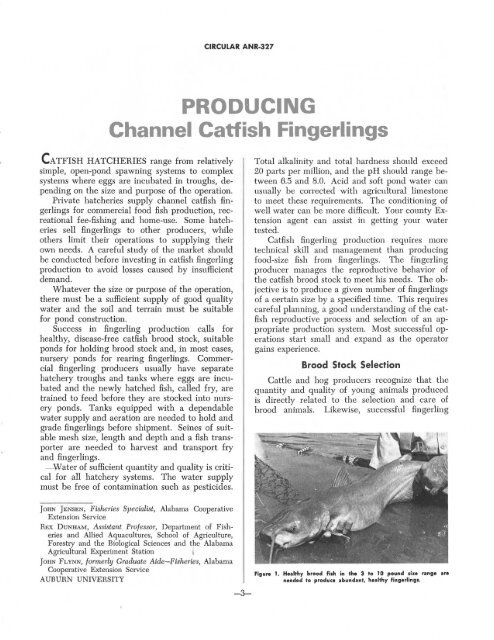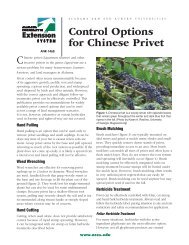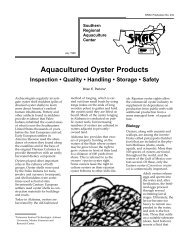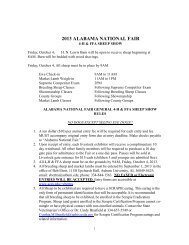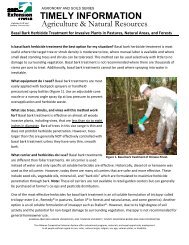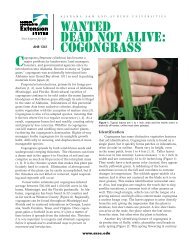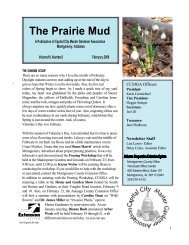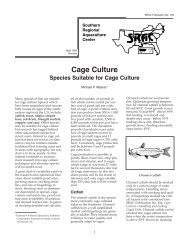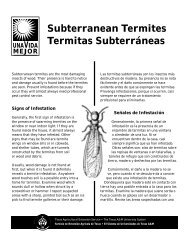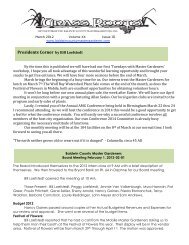PRODUCING - Alabama Cooperative Extension System
PRODUCING - Alabama Cooperative Extension System
PRODUCING - Alabama Cooperative Extension System
You also want an ePaper? Increase the reach of your titles
YUMPU automatically turns print PDFs into web optimized ePapers that Google loves.
CIRCULAR ANR-327<br />
<strong>PRODUCING</strong><br />
Channel Catfish Fingerlings<br />
CATFISH HATCHERIES range from relatively<br />
simple, open-pond spawning systems to complex<br />
systems where eggs are incubated in troughs, depending<br />
on the size and purpose of the operation.<br />
Private hatcheries supply channel catfish fingerlings<br />
for commercial food fish production, recreational<br />
fee-fishing and home-use. Some hatcheries<br />
sell fingerlings to other producers, while<br />
others limit their operations to supplying their<br />
own needs. A careful study of the market should<br />
be conducted before investing in catfish fingerling<br />
production to avoid losses caused by insufficient<br />
demand.<br />
Whatever the size or purpose of the operation,<br />
there must be a sufficient supply of good quality<br />
water and the soil and terrain must be suitable<br />
for pond construction.<br />
Success in fingerling production ca,lls for<br />
healthy, disease-free catfish brood stock, suitable<br />
ponds for holding brood stock and, in most cases,<br />
nursery ponds for rearing fingerlings. Commercial<br />
fingerling producers usually have separate<br />
hatchery troughs and tanks where eggs are incubated<br />
and the newly hatched fish, called fry, are<br />
trained to feed before they are stocked into nursery<br />
ponds. Tanks equipped with a dependable<br />
water supply and aeration are needed to hold and<br />
grade fingerlings before shipment. Seines of suitable<br />
mesh size, length and depth and a fish transporter<br />
are needed to harvest and transport fry<br />
and fingerlings.<br />
- Water of sufficient quantity and quality is critical<br />
for all hatchery systems. The water supply<br />
must be free of contamination such as pesticides.<br />
JoHN JENSEN, Fisheries Specialist, <strong>Alabama</strong> <strong>Cooperative</strong><br />
<strong>Extension</strong> Service<br />
REx DuNHAM, Assistant Professor, Department of Fisheries<br />
and Allied Aquacultures, School of Agriculture,<br />
Forestry and the Biological Sciences and the <strong>Alabama</strong><br />
Agricultural Experiment Station I<br />
JoHN FLYNN, formerly Graduate Aide-Fisheries, <strong>Alabama</strong><br />
<strong>Cooperative</strong> <strong>Extension</strong> Service<br />
AUBURN UNIVERSITY<br />
-3-<br />
Total alkalinity and total hardness should exceed<br />
20 parts per million, and the pH should range between<br />
6.5 and 8.0. Acid and soft pond water can<br />
usually be corrected with agricultural limestone<br />
to meet these requirements. The conditioning of<br />
well water can be more difficult. Your county <strong>Extension</strong><br />
agent can assist in getting your water<br />
tested.<br />
Catfish fingerling production requires more<br />
technical skill and management than producing<br />
food-size fish from fingerlings. The fingerling<br />
producer manages the reproductive behavior of<br />
the catfish brood stock to meet his needs. The objective<br />
is to produce a given number of fingerlings<br />
of a certain size by a specified time. This requires<br />
careful planning, a good understanding of the catfish<br />
reproductive process and selection of an appropriate<br />
production system. Most successful operations<br />
start small and expand as the operator<br />
gains experience.<br />
Brood Stock Selection<br />
Cattle and hog producers recognize that the<br />
quantity and quality of young animals produced<br />
is directly related to the selection and care of<br />
brood animals. Likewise, successful fingerling<br />
Figure 1. Healthy brood fish in the 3 to 10 pound size range are<br />
needed to produce abundant, healthy fingerlings.


